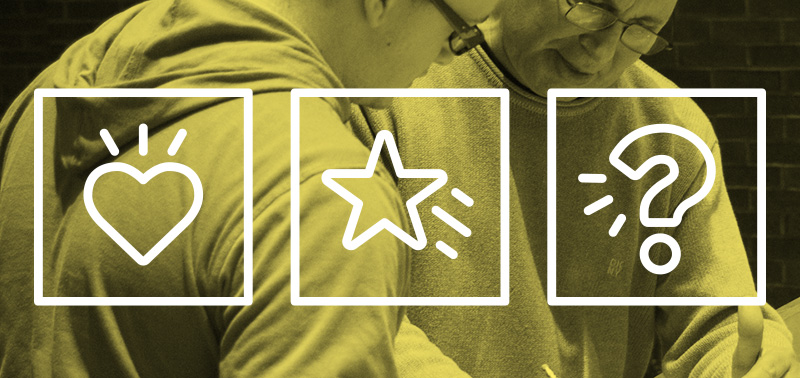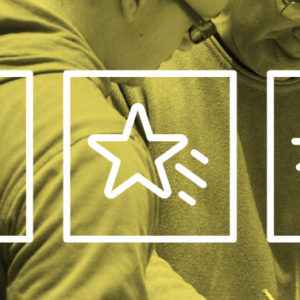There seem to be more books on the topic of collaboration and team-building than shelf space – from visual thinking to leading from within to identifying your animal spirit. But there is one step in the collaborative process that often gets short shrift: intergroup feedback.
In projects where the audience is the ultimate decision-maker, the stakes are high, and egos and nerves can get the best of us. Like any good relationship, having a safe place to express feelings, be heard and experience constructive feedback is important for partnership longevity.
So, if feedback is that important, why do we tend to avoid it? Perhaps it’s our fear of the unknown, egos, desire to be liked or some combination. In our professional life, by the time we’re forming collaborative partnerships, our adult egos are fully developed as well. It can be upsetting for some to hear observations about themselves – positive or negative – that don’t jibe with the images they have of themselves in their heads. In addition, many of us tend to associate feedback with criticism, taking alternative viewpoints, particularly directed at us, as personal attacks. In that same vein, we also fear the ramifications of expressing views that might offend others.
The truth is, feedback is simply a set of observations – positive, negative or neutral – that, when used in a healthy way, helps the team hone its strengths rapidly. So, how can we harness the power of feedback for good in order to build highly functioning teams that create cool stuff? One very simple way is the exercise “I Like, I Wish, I Wonder.” This tool typically is used in “design thinking,” an innovative process that joins creative and analytical approaches with radical collaboration across varying disciplines.
TO BEGIN:
 Turn any surface into a grid with an X and Y axis. On the X axis, place square Post-Its across the top row with the names of each teammate and your group. On the Y axis, do the same with the phrases “I like,” “I wish,” “I wonder” (or “What if?”)
Turn any surface into a grid with an X and Y axis. On the X axis, place square Post-Its across the top row with the names of each teammate and your group. On the Y axis, do the same with the phrases “I like,” “I wish,” “I wonder” (or “What if?”)
 In a brief amount of time, say five minutes for each person and five minutes for the group (total 20), send group members off on their own to complete this assignment. To finish the exercise, a team member uses a minimum of three Post-Its for each colleague and the group as a whole. For each person, they complete each phrase found on the Y axis (“I like,” “I wish,” etc.). NOTE: Strive to be succinct by writing in headline form and remember to use “I” statements for feedback.
In a brief amount of time, say five minutes for each person and five minutes for the group (total 20), send group members off on their own to complete this assignment. To finish the exercise, a team member uses a minimum of three Post-Its for each colleague and the group as a whole. For each person, they complete each phrase found on the Y axis (“I like,” “I wish,” etc.). NOTE: Strive to be succinct by writing in headline form and remember to use “I” statements for feedback.
 When the group comes back together, each member should read his or her Post-Its out loud before placing them onto the grid. After that’s finished, everyone places their Post-Its on the grid by the corresponding person’s name and the correct phase intersect. NOTE: Follow-up dialogue is encouraged, but feedback should go quickly.
When the group comes back together, each member should read his or her Post-Its out loud before placing them onto the grid. After that’s finished, everyone places their Post-Its on the grid by the corresponding person’s name and the correct phase intersect. NOTE: Follow-up dialogue is encouraged, but feedback should go quickly.
 After the grid is filled, take a minute to ask the group if there are any patterns or areas of concern to be conscious of for next meeting.
After the grid is filled, take a minute to ask the group if there are any patterns or areas of concern to be conscious of for next meeting.
 Watch for members who choose not to participate or whose feedback tends to be all critical or all positive.
Watch for members who choose not to participate or whose feedback tends to be all critical or all positive.
Many group members find they look forward to this exercise following a work session, as it allows teammates to decompress and process the day together. As the group gets more comfortable with the process, some of the formalities will fade away, and the exercise will get tweaked to suit the group’s needs. For the most effective results, use the “I Like, I Wish, I Wonder” after the team has had a full day of work (or the equivalent in hours) in order to have enough information from which to work.
The best co-creators incorporate a regular feedback loop into their work, particularly in brand-new or highly diverse partnerships, where the chance for misunderstanding is high and relationships are tender. Whether using a formal exercise like “I Like, I Wish, I Wonder” or you prefer a looser format for feedback, here are a few time-tested guidelines that work:
- View feedback as a gift of insight not as a means of punishment. If we see part of our responsibility on a team as helping our partners realize their full potential, then we value their insights in the spirit they were given.
- Use “I” statements for feedback. “I like how you got us to focus;” “I wish you had not taken a phone call during our brainstorm;” “I wonder what would happen if you spoke up more.” There’s a little less heat when it comes from I.
- When you are the giver of feedback, use a gentle, measured voice and good eye contact. Consider how would you want to be talked to when being given sensitive information.
- When you are the receiver of feedback, use good listening skills so the person giving it feels heard. Allow them to finish the sentence including waiting a pause, following their last word.
- Consider what feedback you choose to give and why. Feedback is always as much about the one giving it as it is about the one receiving it.
- Pay attention to the feedback you choose to accept or reject and why. You are the captain of your own ship, and you can choose what information you act upon. However, if you are hearing the same feedback over and over again in different situation, pay attention.
- Incorporate feedback into every collaboration session. This takes fear and internalizing out of the process.
This piece originally appeared on 21CM.org.







